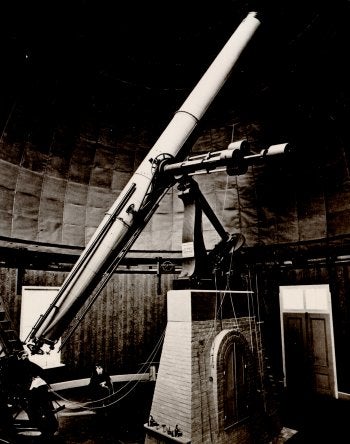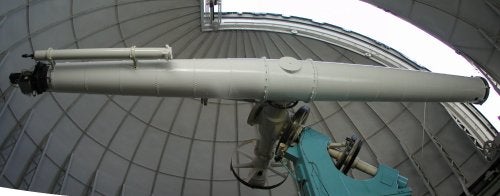Since that time, the telescope has been used primarily to observe double stars and the moons of the outer planets. In the 1990s, the old micrometers and plate cameras were replaced with a CCD speckle-interferometry camera, and visual use of the telescope has since been very limited. However, in 2001, the speckle camera went on a “world tour” to Kitt Peak National Observatory in Arizona and Cerro Tololo Inter-American Observatory in Chile, offering a precious window to visually observe Mars during its summer opposition. I leapt at the opportunity.
The evening of June 24, 2001, was sultry; probably similar to the August weather Asaph Hall had experienced 124 years earlier. A few friends and I opened the dome of the great telescope, removed the lens cover from the gem-like objective, balanced the tube, and turned the instrument toward Mars. Unlike Hall, however, we knew what we were looking for. The planet was hanging low in the south; by midnight it was on the meridian, but only 25° high. The seeing was terrible, but surface detail wasn’t our quarry. To make matters worse, the eyepiece was in such a position that I had to climb onto the control desk to use it.
I had chosen this night because both moons were close to their greatest eastern elongations from the planet, and sure enough, I was quickly rewarded by the sight of two starlike objects dancing in the turbulence and glare from the nearby limb of Mars. One by one I let my friends take a look.
“Ladies and gentlemen,” I intoned after everyone had taken their turn at the eyepiece, “You have just seen the moons of Mars through the very telescope that discovered them.”
I don’t know what impression that may have left on my friends, but I count it as one of the greatest moments I have had at the eyepiece of any telescope. I could almost hear Asaph Hall calling excitedly to his assistant, George Anderson, in the heat and solitude of that August night in 1877.
Geoff Chester has been actively involved in amateur and professional astronomy for more than 40 years. He is currently the Public Affairs Officer for the U.S Naval Observatory in Washington, D.C.











